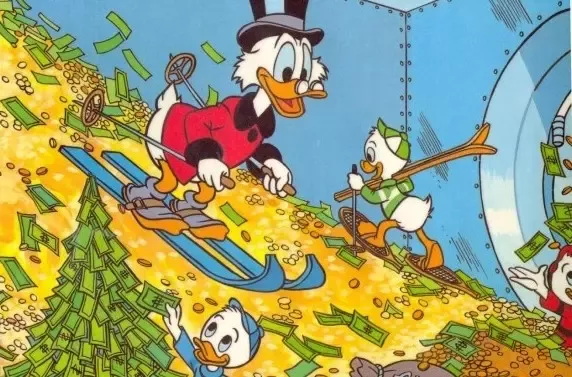I won’t bore you with all the financial details about Disney’s quarterly earnings in this article, I’ll focus primarily on everyone’s favorite streaming service: Disney+. Overall, Disney beat expectations, with total divisional operating income growing 19% to now reach $4.225 billion (Disney’s quarterly revenue is essentially equal to Hasbro’s annual total). Theme park growth has slowed due to inflation, and classic linear TV is still in decline. But let’s look at Disney+! So click to see more!

Bob Iger’s favorite pastime
Disney proudly reports that their streaming division made a slim profit of $47 million! That’s a significant turnaround for the company compared to a loss of $512 million in the same period last year.
But when you look at the actual details, the picture is less rosy. As it turns out, ESPN is solely responsible for monetizing its streaming business.
Disney+ and Hulu lost a combined $19 million. Of course, this is still a huge improvement, but still not profitable. In addition, Disney won’t reveal how much money it makes from Disney+ and Hulu, so it’s anyone’s guess how much Disney+’s actual profits are.
If we look at the subscriber count, the trend here is pretty unremarkable.
In the United States and Canada, Disney+ added about 800,000 new subscribers last quarter. Disney+ currently has 54.8 million subscribers in the United States and Canada.
Excluding India/Hotstar international subscriber numbers have stagnated, falling by 100,000, and currently stand at 63.5 million. Hotstar lost another 500,000 subscribers in India. So while the official PR press release talks about 1% core Disney+ growth, all of this very modest growth is coming from the U.S., while subscriber numbers outside the U.S. are either stagnant or declining.
By comparison, while Disney added 800,000 subscribers in North America (excluding Mexico), Netflix added 8 million new subscribers and lost 600,000 subscribers in foreign markets.
According to the Nielsen Streaming Gauge (streaming media service market share analysis), Disney is working hard to surpass Tubi and currently ranks sixth among streaming services in North America, with a market share of 2%. Netflix has a market share of 8.4%. In short: given Disney+’s massive subscriber base, its market share is minuscule. And Hulu’s market share continues to decline. So while streaming is becoming more important overall, and while Disney’s sheer numbers are growing, other services are growing much faster. It speaks volumes that Netflix added 8 million subscribers (global), while Disney added 700,000 subscribers (excluding India), or 200,000 if all regions are included.
Even worse: Average revenue per customer in the US/Canada fell to $7.74 from $8 last quarter.
So it’s no surprise that earlier this week Iger announced all sorts of things: price hikes this fall and a crackdown on password sharing like Netflix did not long ago. Netflix’s password-sharing crackdown has been a huge success story for Netflix. It’s now really drawing a lot of ire from former freeloaders who, conversely, don’t want to miss Netflix and subscribe to it. Iger clearly hopes the same will apply to people who are currently getting Disney+ for free because a friend or family member shared their password.
It seems to me that Iger is missing something: Netflix has truly compelling content. Not only is Star Wars or Marvel the only exclusive content worth paying attention to, but there’s something for everyone every week.
So, yes, while Disney has stopped splurging on streaming services, it comes at a cost. Content production for Disney+ has slowed to a crawl. The two upcoming new Marvel shows are “old news” in that they were completed a while ago but had their release dates pushed back. We don’t have anything new on the Star Wars side of things. Andor was greenlit for a second season a few years ago, where the show ends. Ahsoka could arrive in 2026, or 2027, no one knows. Skeleton Crew, like The Acolyte, was definitely not going to get more than one season. So what new shows or content is coming to Disney’s streaming service? Same as Marvel. The only two shows we know of right now are going to be huge flops. Agatha Harkness (if you ask “Who?”, you have the answer) and Ironheart aka Riri Williams (again, if you ask “Who?”, you have the answer) would both fail. No new Marvel news has been announced on Disney+.
If Iger’s idea is to stop making exclusive content for Disney+, it would certainly accomplish one goal: Disney would stop losing so much money. But what about the other goal? Growth and more market share? How does Disney+ compete with services like Netflix, Amazon Prime, and even Max when they have real hit shows and Disney+ has… Like Echo (a massive flop), The Acolyte (a massive flop) and more in the making? While Netflix made a sequel to “Beverly Hills Cop,” Disney made a disastrous “Peter Pan” movie on its streaming platform.
So I wouldn’t be surprised if Disney’s crypto crackdown simply doesn’t achieve the same results as Netflix. Because the only reason to own Disney so far is to archive, all the movies you can play on loop, maybe to stop the kids from bothering their parents all day long (which is ironic). It’s just that in the US, Disney doesn’t have a good reputation for providing content for certain groups of children.
As far as price increases go: starting in October, Disney+ will cost $9.99 for Basic and $15.99 for Premium. But Disney really wants you to get one of their bundles.
The basic Hulu and Disney+ bundle with ads is $16.99, remember, this comes with ads! The ad-free plan remains $19.99.
The new bundle with Hulu, Disney+ and Warner’s Max costs $16.99 for the basic plan that includes ads, or $29.99 if you consider the streaming service to not include any ads.
So while Disney is still making a lot of money as a company, and anyone expecting it to stumble and fall will forever be disappointed, their mainstay streaming platform Disney+ is nowhere near as competitive and in good shape as Iger admits. But even theme parks are now feeling the effects of rising inflation, with attendance stagnating and profits slowly falling 6% to a still respectable $1.3 billion for a domestic park. But Netflix will always be out of reach. Prime also has more market share. Hulu still has more market share than Disney+, but it’s declining and has been declining for a long time. Disney+ competes with tubi for the fifth spot. Additionally, Disney lacks any compelling exclusive content these days. It doesn’t have House of the Dragon, it doesn’t have The Boys, it doesn’t have Bridgerton. It remains to be seen how many people will be willing to pay $10 a month or more for a service that increasingly is just a back catalog with no compelling exclusive content.
Another thing to add is that all streaming services suffer from inconsistent customer bases, and it has become common for people to sign up for a month or two to watch all the content they want and then cancel their subscriptions. Netflix has an effective way to combat erratic customer behavior: they launch new products almost every week. Disney puts out four or five exclusive shows a year that could theoretically appeal to a wider audience (Marvel and Star Wars), but there’s no such thing. Here, signing up for a month is enough to watch all the new stuff… and then you can wait a year and sign up again for a month.
Disney+ has no Stranger Things, no Bridgerton, no Squidward, and Disney+ spends all its money on two things: Marvel and Star Wars. Hulu at least had the moderately successful “Bear,” and earlier this year also had “Shogun,” which was moderately successful (albeit nowhere near any of Netflix’s successful series). In short: Disney+ just lacks interesting exclusive content outside of Star Wars or Marvel, and while Disney might be surprised, not everyone wants to watch Star Wars and Marvel, and would rather watch movies like Bridge Something like this. Disney’s failure to create any successful content for Disney+ outside of The Mandalorian could become one of their biggest problems. Unless Iger is satisfied that Disney+ is no longer burning money and is relegated to a primary archive of older movies and shows.
Disney shares fell further after the report was released. The price is now just over $85. Shares are down more than $5 in the past two days. Disney’s stock price has fallen overall by 49% in the past three years.
In case you were wondering: neither Star Wars nor Marvel were mentioned once. It wasn’t in the report, it wasn’t in the briefing, and it wasn’t on analysts’ earnings calls. there is nothing. Quiet.
Disney earnings report

